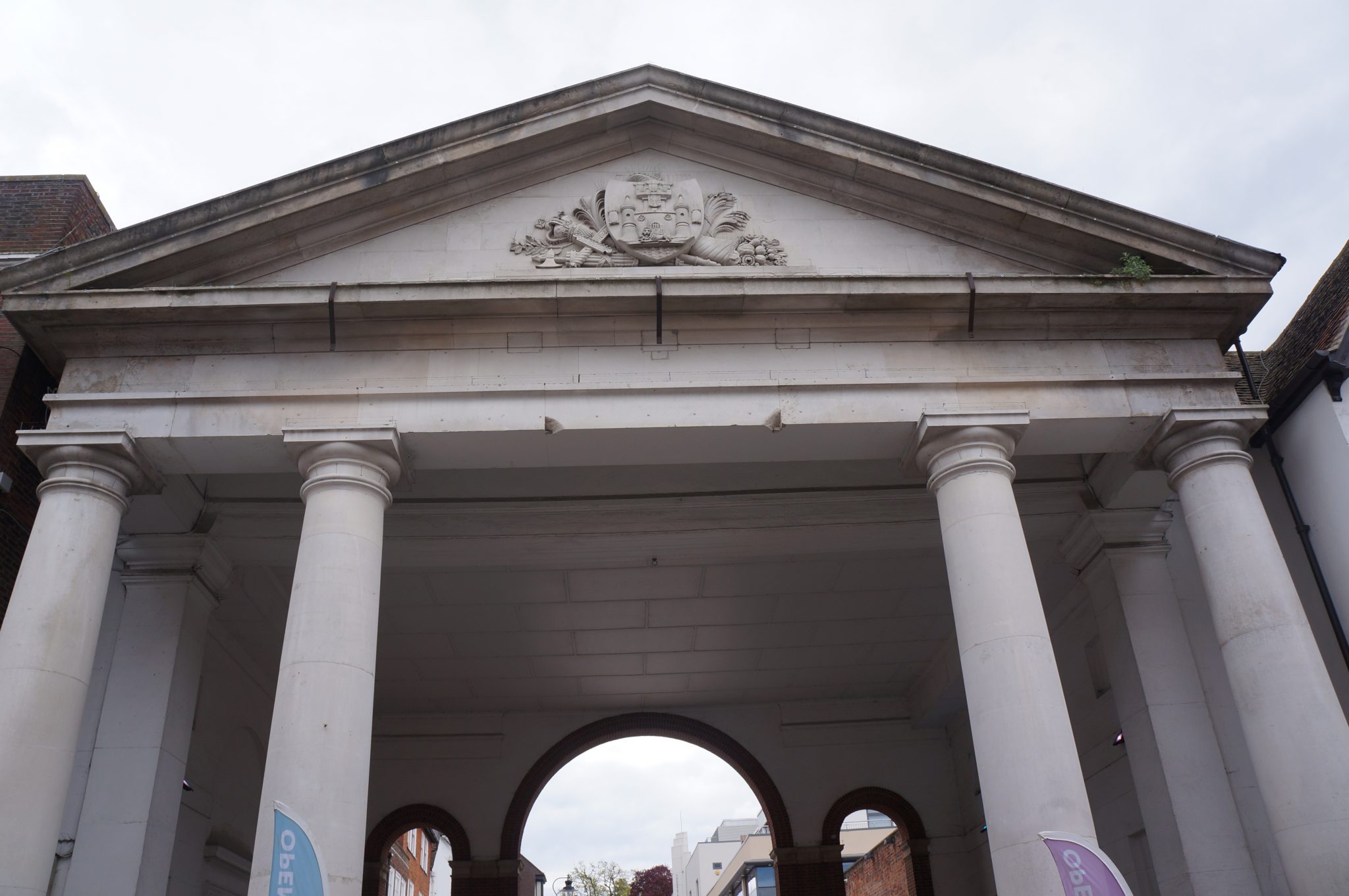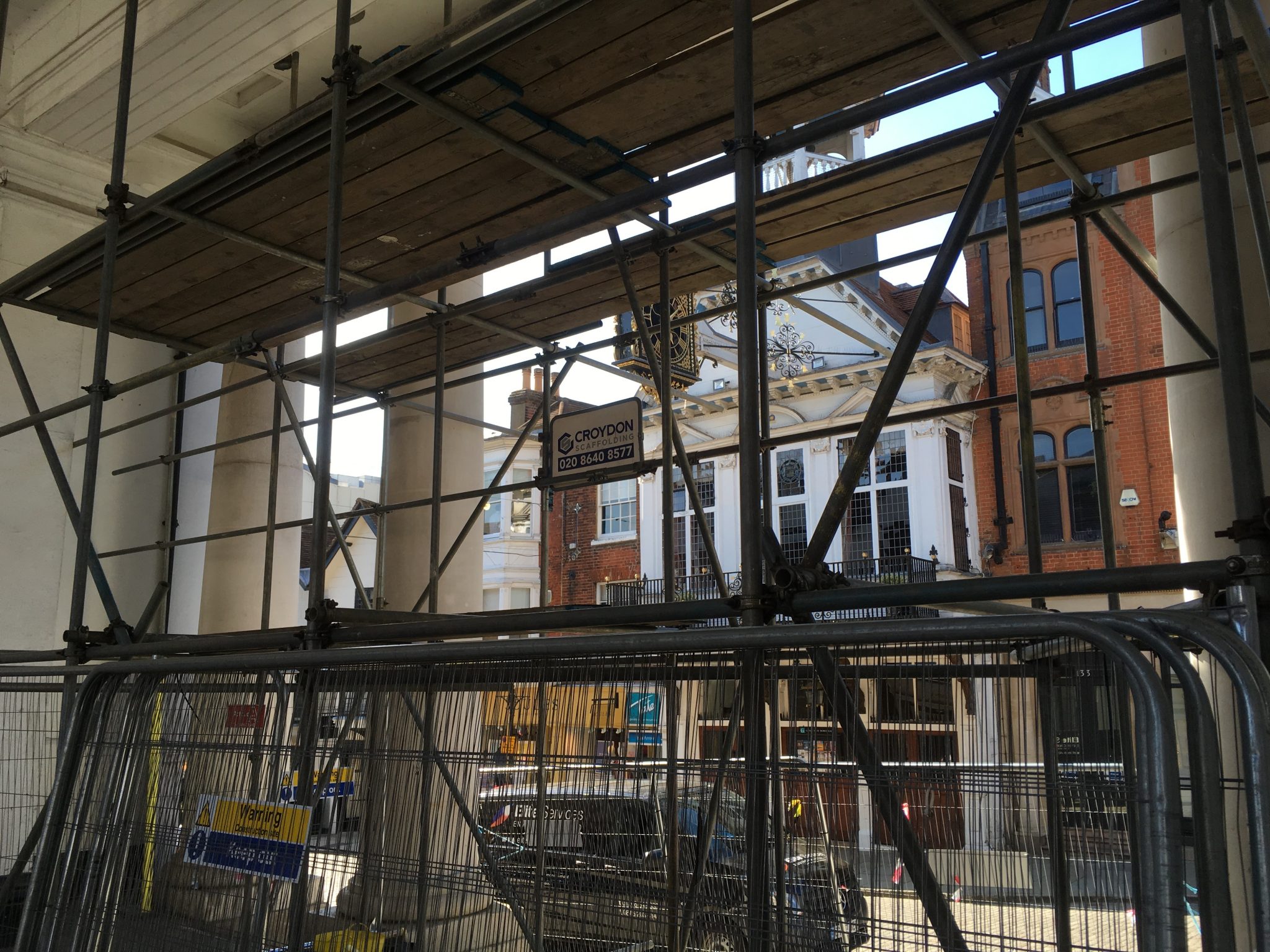 Abraham Lincoln
If given the truth, the people can be depended upon to meet any national crisis...
Abraham Lincoln
If given the truth, the people can be depended upon to meet any national crisis...
 Guildford news...
for Guildford people, brought to you by Guildford reporters - Guildford's own news service
Guildford news...
for Guildford people, brought to you by Guildford reporters - Guildford's own news service
Investigations Start Into Tunsgate Arch Masonry Fall
Published on: 21 May, 2019
Updated on: 24 May, 2019
By Hugh Coakley
Investigations have started to establish the cause and the repair strategy for Tunsgate Arch after a piece of stone broke off from the structure on to the steps below on February 16 (2019).
Guildford Borough Council had cordoned off the area and had checked whether further spalling was likely. As a precautionary measure, a further section of stone was removed on Thursday, February 21 as it was revealed to be fractured as well.
The second stone was found to have non-ferrous pinning. The council believes that this was caused in 2004 during roof repairs and cleaning of the building. Both pieces of masonry at either end of a masonry beam appear to have suffered from compressive cracks.

Two sections of stone missing from the central section of Tunsgate arch. One had fallen from the arch and the other had been removed as a precautionary measure.
The investigation work is being carried out by Cooper & Withycombe, of North Street, Guildford, a firm of structural engineers and building surveyors
The lead consultants and the contractor for the repair work is Paye, specialists in stone repair work on historic structures.
The work is expected to be completed in August 2019.

Matthew Alexander.
Guildford’s honorary remembrancer Matthew Alexander summarises the history of Tunsgate, which is not just the arch…
“Tunsgate took its name from a long-vanished High Street inn called the Three Tuns. ‘Gate’ was the name given in Guildford to the alleyways that led off the High Street.
“The Three Tuns had been knocked down in 1818 to build a new corn market for Guildford’s flourishing grain trade. It had a frontage like a Roman temple of the Tuscan order, with the borough arms and “symbols of agricultural and civic prosperity” in the tympanum.
“The Tunsgate alleyway to Castle Square ran between the two left-hand columns. The corn market (or ‘corn exchange’) was also used as a courtroom when the assizes sat in Guildford; but not a very satisfactory one. The courts were moved to the County Hall in North Street in 1861.
“In 1901 the corn market was moved to Woodbridge Road, and the building was used as offices for Guildford Borough Council. In late 1936, it was partly demolished, leaving only the street frontage with its classical portico. The two middle columns were moved further apart and the steps removed to allow vehicles to drive from the High Street along Tunsgate, which had been widened.
“In the early 1980s the front steps were reinstated, so blocking it for through traffic. Now many Guildford people refer to the old archway as ‘Tunsgate’. In fact, it is the street that is Tunsgate: the archway is all that’s left of the old corn market, once an important part of the town’s commercial life.”
Further information on the arch was provided by a Guildford Borough Council spokesperson: “The Grade II listed structure has a Portland stone facade on a brick backing with ashlar stone inner walls and brick rear wall.
“The roof and soffit structures are in timber. In 1936 the front columns were moved apart and the rear arches rebuilt to form a roadway through the arch wide enough for motorised vehicles. This was achieved by inserting a composite steel beam spanning the repositioned inner columns to pick up the thrust from the relieving brick backing arches to the cornice stonework supporting the pediment.
“Steel rods are assumed to hang from the beam affixed to flat steel plates that pick up the load of the stonework spanning between the re-positioned inner columns.”
Responses to Investigations Start Into Tunsgate Arch Masonry Fall
Leave a Comment Cancel reply
Please see our comments policy. All comments are moderated and may take time to appear. Full names, or at least initial and surname, must be given.Recent Articles
- A Lighthouse in the Centre of Town Showing the Way to Community
- Letter: SCC Directs Weedkilling Policy
- Library Gets Lottery Grant To Raise Awareness of Green Issues
- Story of Wartime Canadian Army Entertainment Unit Based at Down Place, Guildford
- Flashback: Around the Very Top: Slow Progress to Our First Remote Stop
- Letter: Weeds Are Just Flowers in the Wrong Place
- Summary of GBC Planning Decisions – May 21, 2025
- Discounted Parking Scheme for Night-time Economy
- Guildford Museum Shares Jekyll’s Boots with British Library for New Exhibition
- Stoke Park Paddling Pool Stays Closed After Tests Show Contamination


Recent Comments
- Kit Collins on Letter: Is This the Ugliest Building in Guildford?
- Barbara Ford on Notice: Have a Blooming Picnic – June 7
- M Durant on Millions of Taxpayer Money Recovered from Railway Fare Dodgers
- Jim Allen on Letter: If GBC Wishes To Be Nature-friendly, Stop Spraying Weedkiller
- John Lomas on Stoke Mill To Be a Pub If Plans Are Approved by Borough Council
- Rebecca Brion on Letter: Is This the Ugliest Building in Guildford?
Search in Site
Media Gallery
Dragon Interview: Local Artist Leaves Her Mark At One of England’s Most Historic Buildings
January 21, 2023 / No Comment / Read MoreDragon Interview: Lib Dem Planning Chair: ‘Current Policy Doesn’t Work for Local People’
January 19, 2023 / No Comment / Read MoreA3 Tunnel in Guildford ‘Necessary’ for New Homes, Says Guildford’s MP
January 10, 2023 / No Comment / Read More‘Madness’ for London Road Scheme to Go Ahead Against ‘Huge Opposition’, Says SCC Leader
January 6, 2023 / No Comment / Read MoreCouncillor’s Son Starts Campaign for More Consultation on North Street Plan
December 30, 2022 / No Comment / Read MoreCounty Council Climbs Down Over London Road Works – Further ‘Engagement’ Period Announced
December 14, 2022 / No Comment / Read MoreDragon Interview: GBC Reaction to the Government’s Expected Decision to Relax Housing Targets
December 7, 2022 / No Comment / Read MoreHow Can Our Town Centre Businesses Recover? Watch the Shop Front Debate
May 18, 2020 / No Comment / Read More













Colin Selvin
May 22, 2019 at 10:39 am
I’m confused. Surely non-ferrous fixings are exactly what would be required. Expansion of ferric fixings upon rusting damages masonry.
Also interesting to speculate what fixings of the stone beam would be fitted during “roof works”.
Any more informed readers out there able to clarify, please?